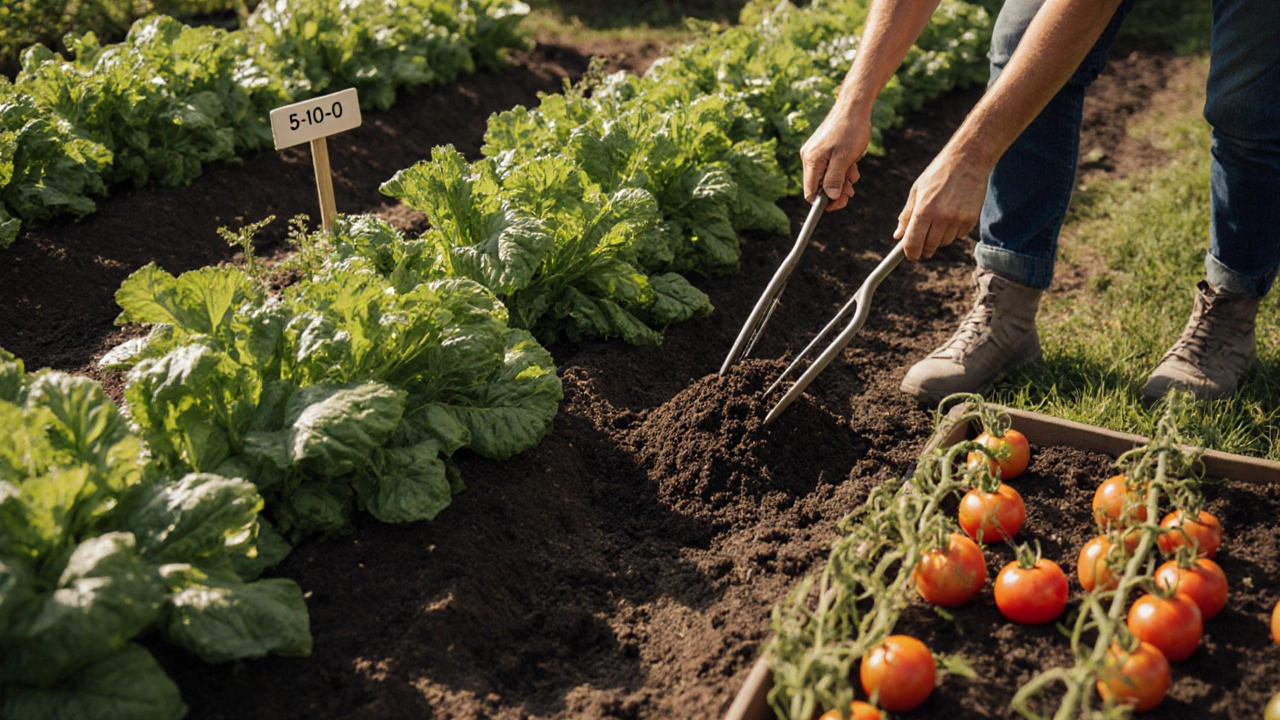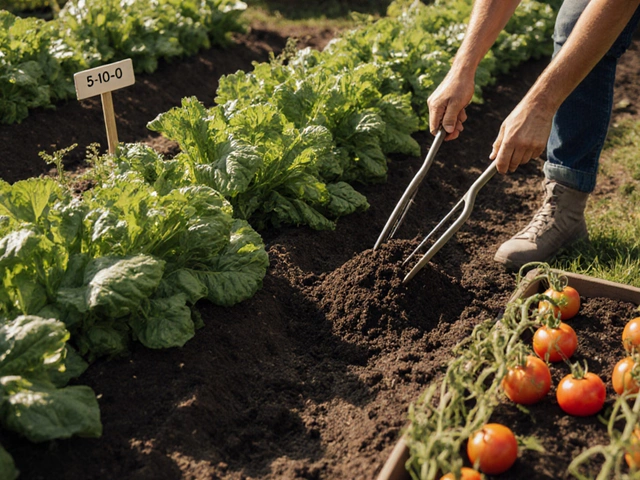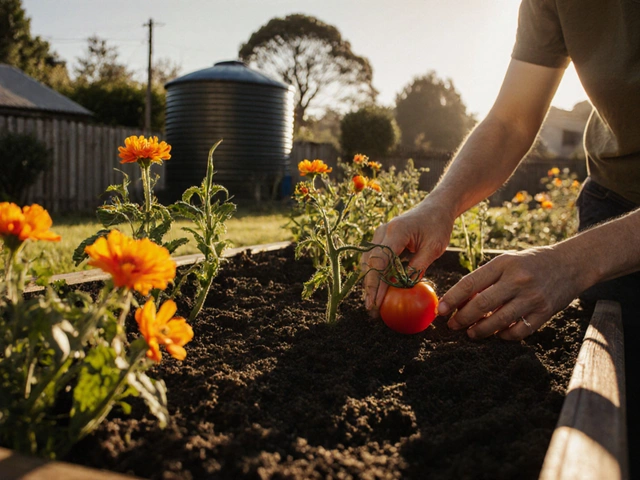Vegetable Fertilizer Calculator
Optimal Fertilizer Calculator
Get personalized fertilizer recommendations based on your vegetable type and growth stage
Recommended Fertilizer
Key Nutrients
When you plant seeds in the soil, you’re not just growing food-you’re building a living system. And like any system, it needs the right fuel. Too much fertilizer can burn your plants. Too little, and your tomatoes stay small, your peppers turn pale, and your zucchini yield drops to nothing. The question isn’t just which fertilizer is best for vegetables, but which one works with your soil, your climate, and your goals.
What vegetables really need
Vegetables aren’t all the same. Leafy greens like lettuce and spinach want more nitrogen to grow big, dark leaves. Tomatoes, peppers, and eggplants need a boost of phosphorus to set fruit. Root crops like carrots and potatoes thrive with extra potassium to build strong tubers. Most store-bought fertilizers list three numbers on the bag-N-P-K. That’s nitrogen, phosphorus, and potassium. For most vegetable gardens, a balanced 5-10-10 or 10-10-10 works well early in the season. But as plants start flowering and fruiting, they shift needs. That’s when a lower-nitrogen, higher-phosphorus formula like 5-10-15 kicks in.
Many gardeners make the mistake of using lawn fertilizer on their veggies. That’s like giving a marathon runner candy before a race-high in nitrogen, low in what they actually need. Lawn fertilizers push leafy growth, not fruit. Your tomatoes will look lush but produce almost nothing. Stick to formulas made for vegetables.
Organic vs. synthetic: what’s the real difference?
Organic fertilizers come from living things-compost, manure, bone meal, fish emulsion, kelp. Synthetic ones are chemically manufactured. Both supply nutrients. But they work differently.
Synthetic fertilizers dissolve fast. You water them in, and your plants drink up in days. Great if your spinach is turning yellow and you need a quick fix. But they don’t improve soil. They feed the plant, not the dirt. Over time, you end up with compacted, lifeless soil that needs more and more fertilizer just to keep up.
Organic fertilizers break down slowly. They feed microbes first, and microbes feed the plants. It’s a chain reaction. You won’t see results overnight, but your soil gets better each year. A 2023 study from the Rodale Institute found that organic vegetable gardens produced yields equal to conventional ones after three years-while using 30% less water and building 15% more organic matter in the soil.
Here’s the catch: organic doesn’t mean safe. Too much chicken manure can burn roots. Too much fish emulsion smells awful and attracts raccoons. Always follow the directions. Organic doesn’t mean “more is better.”
Top 5 fertilizers for vegetable gardens in 2025
Not all fertilizers are created equal. Here are five that consistently deliver results in real gardens, backed by grower feedback and soil tests.
- Compost - The gold standard. It’s full of microbes, humus, and slow-release nutrients. A 2-inch layer worked into the topsoil before planting gives your whole garden a foundation. You can make it yourself or buy bagged compost from garden centers. Look for dark, crumbly, earthy-smelling stuff. If it smells sour or looks chunky, skip it.
- Bone meal - High in phosphorus (about 15-20%). Perfect for tomatoes, peppers, and root crops. Sprinkle 1/2 cup per plant at planting time. It’s slow, so it lasts through the season. Avoid if you have dogs-they love the smell and will dig it up.
- Fish emulsion - A liquid fertilizer made from ground-up fish. Rich in nitrogen and micronutrients. Dilute 1 tablespoon per gallon of water and apply every two weeks. Great for side-dressing growing plants. Use it early morning or late evening-strong smell fades by nightfall.
- Seaweed kelp extract - Not a primary nutrient source, but it’s packed with natural growth hormones and trace minerals. Boosts plant resilience to heat, pests, and drought. Spray on leaves every 10-14 days. Works wonders for stressed plants.
- Organic granular blend (like Dr. Earth or Espoma) - Pre-mixed, easy to use. These blends often combine bone meal, blood meal, kelp, and humates. Apply at planting and again mid-season. They’re odorless, pet-safe, and designed specifically for vegetables.

When and how to apply fertilizer
Timing matters more than the product. Fertilizing too early or too late wastes money and harms plants.
At planting time, mix a slow-release granular fertilizer into the soil around the root zone. Don’t dump it directly on the seed or stem-this causes burn. For transplants, sprinkle a handful of compost or organic blend into the hole before placing the plant.
Once plants are established, wait until they start flowering before adding more. That’s when they need phosphorus and potassium the most. Side-dress by gently scratching fertilizer into the soil 4-6 inches away from the stem. Water it in well.
For leafy greens, you can apply a light liquid feed every 3 weeks. For fruiting crops, one mid-season boost is usually enough. Over-fertilizing leads to lush vines but no fruit. It’s a common mistake.
Signs your vegetables need fertilizer
You don’t need a lab test to know your plants are hungry. Look for these clues:
- Yellowing older leaves - Classic nitrogen deficiency
- Purple or reddish stems - Phosphorus shortage, especially in cool soil
- Weak stems, poor fruit set - Likely low potassium
- Slow growth despite plenty of sun and water - Could be nutrient imbalance or depleted soil
Don’t rush to fertilize if your plants look sick. First, check for pests, overwatering, or poor drainage. Nutrient problems are often symptoms of deeper issues.

What to avoid
Some popular gardening advice is flat-out wrong.
Don’t use fresh manure. It’s too hot. It can burn roots and harbor harmful bacteria like E. coli. Always use aged or composted manure-at least 6 months old.
Don’t rely on coffee grounds alone. They’re slightly acidic and low in nutrients. A handful mixed into compost is fine. Sprinkling them directly on the soil won’t feed your plants-it might even repel earthworms.
Don’t use “miracle” powders or liquid boosters that promise instant results. If it sounds too good to be true, it is. Real gardening takes time. Healthy soil grows healthy plants. No shortcut replaces that.
Test your soil once a year
Even the best fertilizer won’t fix bad soil. Every fall, after harvest, take a soil sample. Mix soil from 5-6 spots in your garden, about 6 inches deep. Let it dry, then send it to your local cooperative extension office. Most charge $15-$25. You’ll get a report telling you exactly what’s missing and how much lime or fertilizer to add.
It’s the only way to know if you’re over-applying phosphorus (common in urban gardens) or if your pH is too high or low. Most vegetables like a pH between 6.0 and 6.8. Outside that range, nutrients become locked up-even if you add fertilizer, your plants can’t use them.
Final tip: Build soil, not just plants
The best fertilizer for vegetables isn’t a bag you buy. It’s the soil you nurture. Add compost every year. Plant cover crops in fall. Mulch with straw or leaves. Rotate crops so you don’t drain the same nutrients year after year. Over time, your garden will need less and less fertilizer-and produce more and more food.
Start with compost. Add bone meal for fruiting plants. Use fish emulsion for a mid-season boost. Test your soil. And forget the quick fixes. The best vegetables come from healthy soil-not magic powder.
Can I use fertilizer on my vegetable plants every week?
No. Most vegetable plants only need fertilizer two or three times during the growing season: at planting, when they start flowering, and maybe once more if they look weak. Weekly feeding can burn roots, cause leaf burn, and lead to poor fruit production. Slow-release organic fertilizers last for months. Liquid feeds like fish emulsion should be used every 2-3 weeks at most.
Is Miracle-Gro good for vegetables?
Miracle-Gro Water Soluble Plant Food works in the short term-it gives quick green-up and growth. But it’s synthetic and doesn’t improve soil. If you use it every year, your soil will eventually become compacted and lifeless. For long-term garden health, organic options like compost and granular blends are better. Use Miracle-Gro only as a quick fix for stressed plants, not as your main fertilizer.
What’s the best fertilizer for tomatoes?
Tomatoes need more phosphorus and potassium than nitrogen once they start flowering. A 5-10-10 or 3-4-6 fertilizer works best. Bone meal mixed into the planting hole gives a strong start. Mid-season, use fish emulsion or a liquid kelp blend to support fruit development. Avoid high-nitrogen formulas-they make leafy vines but few tomatoes.
Can I use grass clippings as fertilizer?
Yes-but only if they’re dry and free of herbicides. Fresh, wet clippings can mat down and smother plants. Dry them out first, then use them as mulch or mix them into compost. They add nitrogen slowly and help retain moisture. Never use clippings from lawns treated with weed killers-they’ll kill your vegetables.
Why are my vegetable leaves turning yellow?
Yellowing older leaves usually mean nitrogen deficiency. But it could also be overwatering, poor drainage, or a pH imbalance. Check the soil moisture first. If it’s soggy, cut back on water. If it’s dry and the leaves are pale all over, try a light application of fish emulsion or compost tea. Test your soil pH-most vegetables need 6.0-6.8 to absorb nutrients properly.







